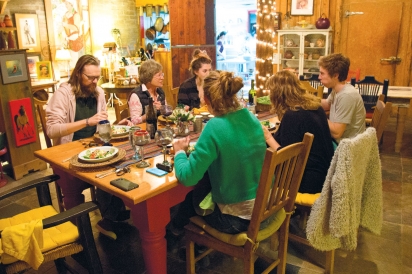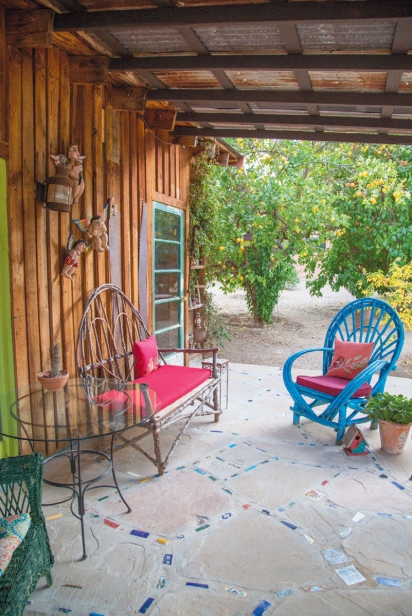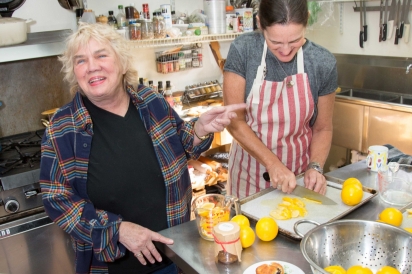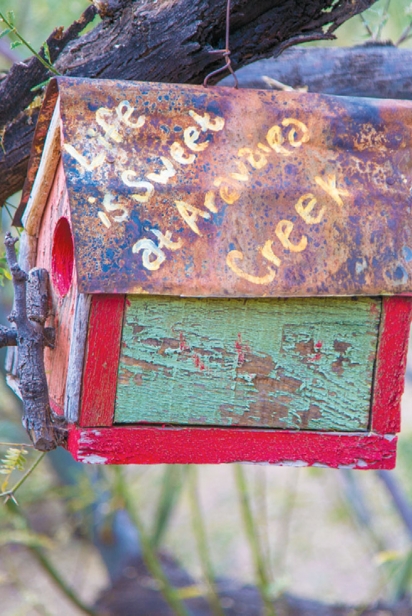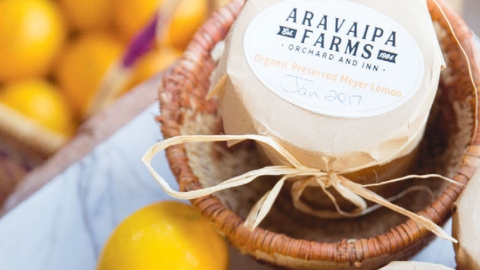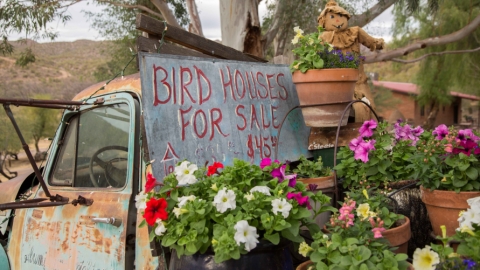A Fruitful Stay at Aravaipa Farms
We’ve packed the SUV and we’re on our way to Aravaipa.
In the Apache language, Aravaipa means “place of little running waters.” A tributary of the San Pedro River, Aravaipa Creek magically emerges from the ground at the east end of an 11-milelong canyon in Eastern Arizona and then winds its way to the San Pedro.
It’s a two-hour trip heading southeast from Phoenix towards Winkleman and copper mining country. The road winds though the scenic saguaro and cholla cactus–studded desert where extraordinary man-made plateaus of mine tailings butt up against and rival the massive peaks of the Galiuro Mountains. We turn left off the highway into Aravaipa Canyon.
The canyon is managed as a BLM wilderness area within a 9,000-acre Nature Conservancy preserve. The lush riparian woodland provides habitat for diverse desert fauna, such as elusive mountain lions, bobcats and bighorn sheep, as well as over 200 species of birds, including rare gray hawks. Open to only 30 day visitors at a time, the wilderness is a rare gem for hikers, birders, photographers, painters and naturalists.
Our group has embarked on a scenic post-holiday journey to Aravaipa Farms Orchard and Inn to explore the secluded guest farm and orchard, and to observe the making of its signature marmalade.
Owners Kevin and Jill Madden acquired the inn in 2016 from well-known gourmet and entrepreneur Carol Steele.
A pillar of the food scene in Phoenix from the 1970s to the 1990s, Steele “fell in love with the food department at Harrod’s in London and wanted to mimic their sense of style and display in her stores.”
She opened C. Steele and Co. in 1976, a Phoenix retail landmark and cooking emporium for food lovers and culinary aficionados. Then, in 1995 at age 59, Steele says she wanted a new creative endeavor, and “to escape from technology.” She sought a place where she could express her love for the art of living well; of growing, cooking and sharing good food with her friends; and pursue her personal artistic endeavors. She discovered the former horse ranch and orchard on Aravaipa Creek and transformed them into a retreat for friends and the public.
Her kitchen garden, flock of chickens and fruit orchard supplied much of the food served to guests for breakfast and dinners. The abundant lemons, oranges and grapefruits inspired the delicious signature marmalade.
After a long stretch on a dirt road, we reach the inn by descending a short but steep canyon wall and fording the creek before passing through the orchard to the lodge.
Nestled at the edge of the canyon, the Aravaipa Farms Orchard and Inn provides delightful lodging. The Inn is a cluster of five cozy well-appointed casitas created from former ranch outbuildings. Shaded by huge sycamore and salt cedar trees, the casitas are surrounded by assorted citrus trees, enormous gnarled cacti, weathered benches, small forests of potted succulents, colorful birdhouses and bright annuals in terra-cotta pots.
Innkeepers and caretakers Laura and Scott Bailey welcome us warmly, show us how everything works in the casita and help us find our way around.
The artifacts, furniture, pottery, sculpture and textiles that Steele once imported from Mexico, her hand-hewn and decorated birdhouses and the Steele-designed hand-painted dinnerware punctuate the Southwestern ambience in a jaunty, whimsical way.
The Maddens share Steele’s vision for a desert get-away for weary urban dwellers. Passionate about good food, they continue to serve delicious dinners sourced from the garden, fruit trees and local producers. They have retained the original charm and ambience of the casitas while updating them, sprucing up the grounds and expanding the orchard.
Arriving mid-afternoon, we have time for a walk through the orchard, past the vegetable garden and a short way up the creek, taking in the sounds of birds and the running stream and desert views.
The canyon has a unique microclimate where temperatures can vary by 10 to 12°F, allowing for different types of fruit production. The “canyon effect” means that the cold air settles on the canyon floor, creating the chill factor (number of hours the tree is exposed to temperatures below 45°) that’s necessary in order to set fruit for apples, peaches, apricots, pears, cherries.
The warmer temperatures on the slope above the canyon floor near the casitas allow citrus trees to grow well, bearing abundant fruit in December and January. Among them: ruby and pink grapefruit, Meyer and Lisbon lemons, oranges and a huge, grapefruit-sized Ponderosa lemon.
Winter and summer vegetables grow organically on the property in repeated plantings just for the farm and guests. Cabbage, Swiss chard, onions, garlic, lettuces and other greens provide winter fare, while in summer abundant tomatoes, okra, root vegetables and peppers are enhanced by basil, thyme, parsley, rosemary and other aromatic herbs. Last summer, annual flowers for bouquets were very successful, and sold well in the farmers markets.
Our 7pm community-table dinner, carefully prepared by cook Polly Choate, begins with a delicious mixed green salad of various lettuces, arugula, crunchy slivers of garden kohlrabi, sweet pink grapefruit, toasted pecans and creamy feta cheese all dressed in a well-balanced vinaigrette. Next Choate serves a succulent roasted chicken, flavored with rosemary and preserved lemons from the trees outside; curry roasted carrots and turnips from the garden; and mixed purple and tender white potatoes with herbs. The generous plateful would seem to leave little room for dessert, but the fresh lemon-infused Bundt cake with mixed berries and whipped cream disappears quickly.
Choate, who lives in the canyon with her husband, Richard, started cooking at the Inn with Steele from 2011 through 2014, when operations wound down. Originally from Wyoming, Choate tells me, “I have a long and diverse background in cooking that includes an Italian deli, catering and working as a private chef. I really enjoyed working with Carol, we had a lot of fun.”
She was uncertain at first about her future at the Inn, but when Choate met the Maddens, who appreciated her talents and with whom she clicked, she agreed to come back. She is a great baker, contributes herbs from her own garden and although vegetarian for many years, under Steele’s tutelage she has become an expert in roasting chicken and preparing other meats.
The morning’s breakfast, awaiting us in the room fridge, includes house-made muffins and granola, butter, marmalade, fruit yogurt, and fresh orange juice, coffee and tea. We enjoy it in a leisurely fashion while looking out over the orchard and watching birds on the terrace outside our room.
For the Maddens, the orchard and farm offer an opportunity to contribute to local food production and practice sustainable agriculture. They provide their fruits to local school districts, farmers markets, food banks and restaurants in Tucson.
This year, the planting of 600 new trees is under way, including Blenheim and Katy apricots; four varieties of peaches; two kinds of pears; Winesap, Fuji and Arkansas Black apples; a pluot and a few cherry trees. These new trees will not bear fruit for some years yet, but a small grove of stalwart, drastically pruned, old Blenheim apricot trees from the original orchard will bear fruit this spring, usually by the end of April.
The large old stand of Hatsui Asian pears will bear abundantly during the summer.
In the fall there will be grapes, apples, pomegranates, pecans and pears, ensuring three full seasons of fresh fruits on the farm. Like many small operations, the orchard is managed organically, but not certified, because as Kevin Madden tells me, the cost is prohibitive for small scale producers like Araviapa Farms.
The Maddens are assisted by farmer and manager Burl Newton, a native of the canyon who planted the original apricot, peach and Asian pear trees in 1984 for former owner Bill Farney. Newton is a master of many trades, including building, plumbing, electrical work, wells and irrigation systems.
The Maddens and Newton replaced the old-fashioned flood irrigation system in the orchard and designed a new one with artesian wells and drip lines. This has reduced the use of stream water by 99%, securing a better habitat to support the 12 species of rare native fish in Aravaipa Creek.
After breakfast we gather in the kitchen to chat with Steele and observe Choate and Laura Bailey make Steele’s famous marmalade in her vintage copper pots. Today it’s Meyer lemon. I ask Steele about her recipe.
She tells us, “I love to read cookbooks, and adapt my recipes using various sources. This one calls for Meyer lemons, but regular lemons can be substituted.”
The recipe works for grapefruits and oranges too. One of her elegant signature touches is to add a half cup of bourbon to six quarts of orange marmalade at the end of the cooking process to give it a smooth finish.
The marmalade is served with breakfast and is available for sale in the Inn’s gift shop along with other farm-made offerings featuring the orchard’s fruit such as preserved lemons.
Aravaipa Farms Orchard and Inn is a great hiking destination, a nurturing farm, artists’ haven and culinary adventure. One day was not enough: A return trip to explore the canyon and see the fruit trees in bloom, or the summer flowers, is high on my travel list. As the birdhouse message says, “Life is Sweet at Aravaipa Creek.” You’ll be glad you made the trip.
Aravaipa Farms Orchard and Inn
89395 E. Aravaipa Rd. Winkleman, AZ 85192 aravaipafarms.com 520-261-7373
Inquire about obtaining a pass in advance if you're interested in hiking the wilderness area. Bring your own alcohol and wine.



